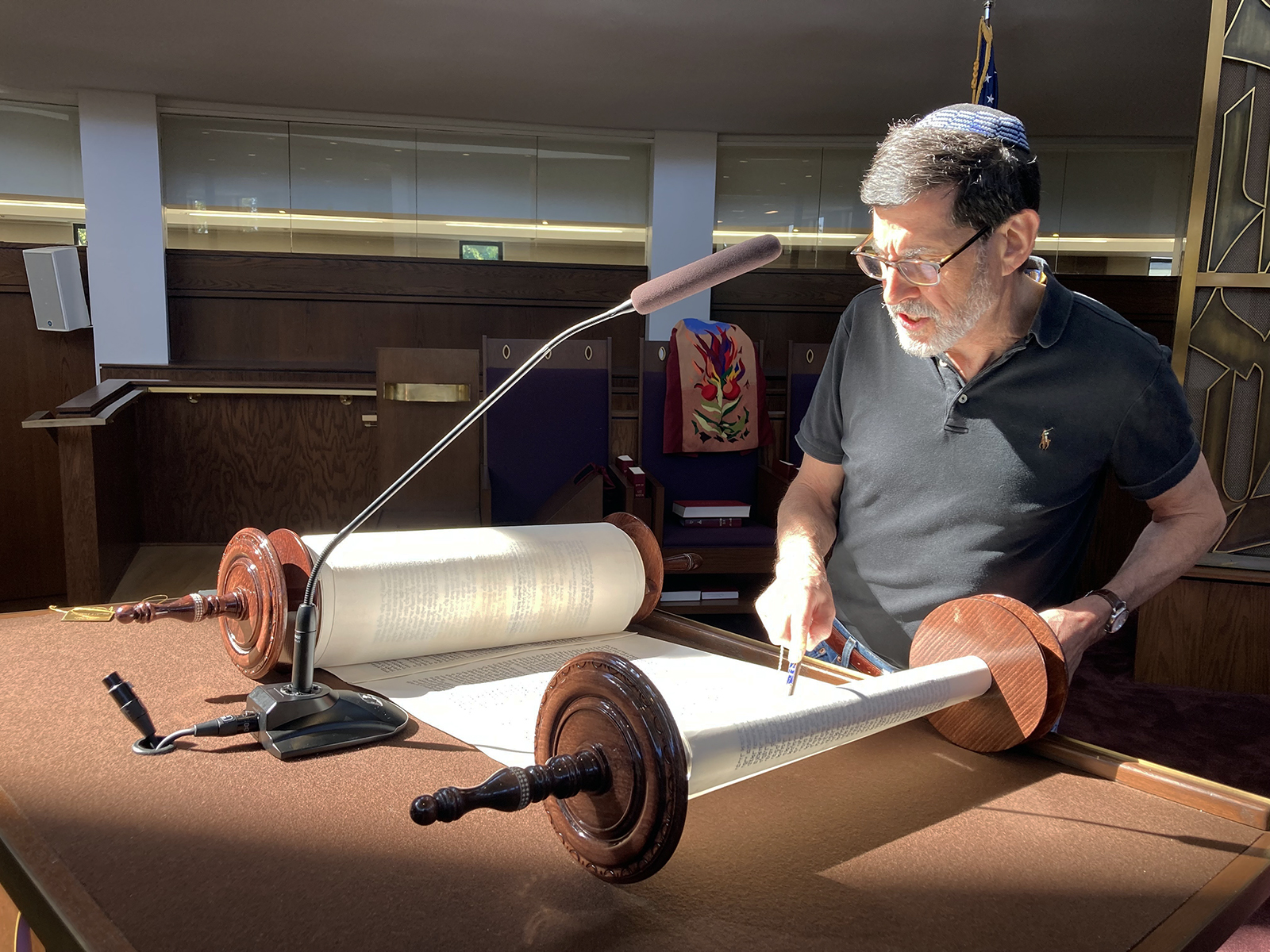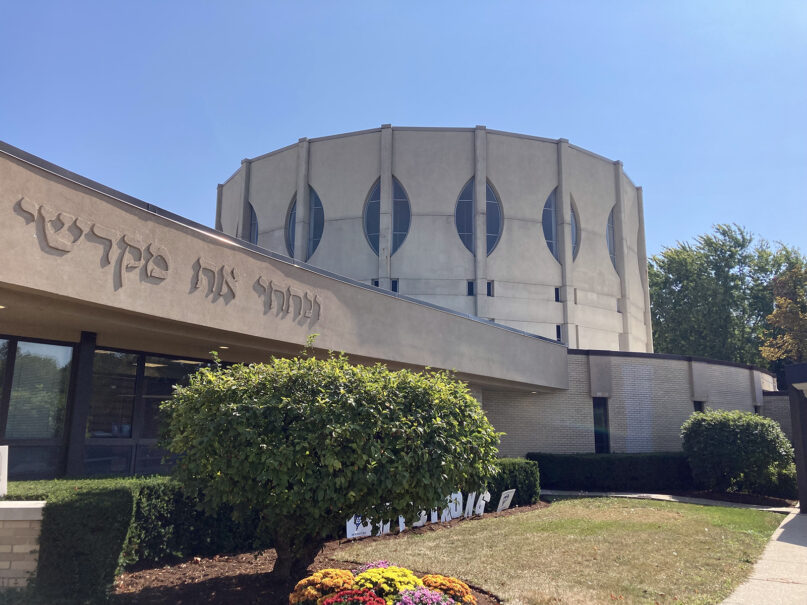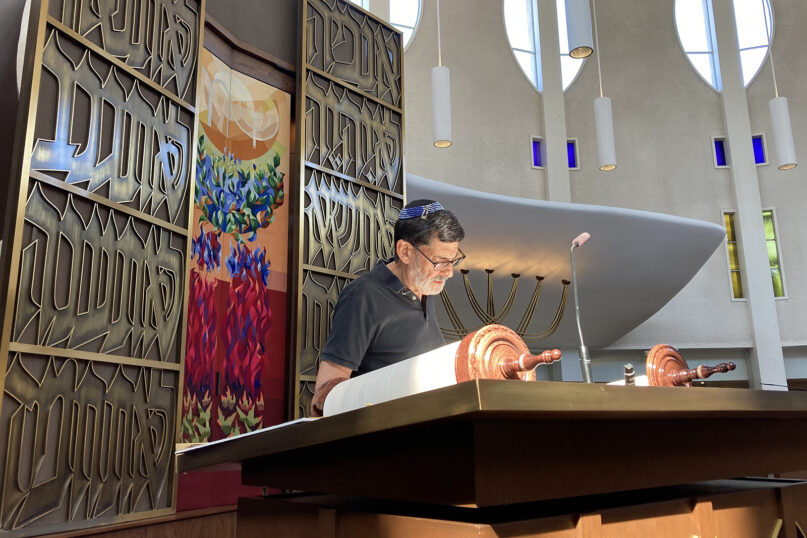
HIGHLAND PARK, Ill. (RNS) — Growing up in Argentina in an assimilated Jewish family, Jorge Singman never had a bar mitzvah, a rite of passage when Jewish teens read from the Torah scroll in front of an entire congregation.
So, earlier this year when his synagogue, North Suburban Synagogue Beth El, began offering classes on chanting Torah, the first five books of the Bible, he signed up. On Aug. 10, the 66-year-old engineer stepped forward during a Shabbat service to chant a passage from the Book of Deuteronomy in Hebrew for the first time in his life.
“I would say it was kind of like my bar mitzvah,” said Singman, who had invited eight friends to his home for a meal to celebrate the occasion later that day. “I loved it.”
It was a milestone, too, for North Suburban Synagogue Beth El. A few years ago, the Conservative congregation of 900 families overlooking Lake Michigan set a goal of signing up 100 new laypeople to learn the ancient system of cantillation, or chanting the liturgy. Just six months later, the synagogue achieved its goal. And yet, it has since continued a series of incentives to get more of its congregants to not only read the ancient Hebrew scroll but put it to melody using the musical notation system devised centuries ago by Torah scholars in the ancient city of Tiberias.
Singman was one of 210 congregants who chanted Torah during services in the Jewish year that just concluded, many for the first time.

Beth and Jorge Singman dine in their sukkah. (Photo courtesy of Jorge Singman)
On Thursday (Oct. 24), as Jews mark the holiday of Simchat Torah (the joy of the Torah), the synagogue will also acknowledge its unique feat. At a time when synagogue attendance is waning across the country, Beth El has engaged more than one-fourth of its members in the sacred task of publicly reciting a portion of the Torah.
Simchat Torah, which marks the end of the High Holiday season, is when Jews read the last chapter of the fifth book, Deuteronomy, which relates the death of Moses. They then roll back the Torah scroll to the beginning and start over with Genesis 1:1, the story of Creation.
The Team Torah challenge, as it’s come to be known, is the brainchild of a committee set up to figure out how to broaden participation in the main portion of the Shabbat worship service beyond the usual group of Torah readers, typically the rabbis, cantors and a select group of laypeople.
The public reading from the Torah scroll forms the heart and soul of the Jewish Shabbat service. Ancient rabbis divided the Torah into 54 portions of two to six chapters each, corresponding with the 54 weeks of the Hebrew calendar’s year. Most Conservative synagogues use a triennial system of reading one-third of the Torah each year. But North Suburban Synagogue Beth El has kept the traditional system of reading the full weekly Torah portion.
“The whole idea was to make Torah reading fun,” said Michael L. Millenson, who chairs the committee. “This doesn’t make everyone who reads a Torah scholar, but it does make them participants in Torah.”
RELATED: Chabad Jews celebrate at 5,000-square-foot sukkah in New York
Chanting Torah from the bimah, the synagogue’s stage, is one of the few ceremonial roles available to laypeople. But it’s not easy. Jews have to be able to read Hebrew and then learn the cantillation system sometimes called “trope” or “trop” in Yiddish, which appears as a series of accents above and below the letters in book bound versions of the Torah but not on the scroll itself. Most 12- and 13-year-olds preparing for their bar or bat mitzvah learn the system but then promptly forget it if they don’t continue to practice it.

North Suburban Synagogue Beth El in Highland Park, Ill., set a challenge of getting more laypeople to chant Torah. During the Jewish year that just concluded, 210 people stepped up. (RNS photo/Yonat Shimron)
Joshua Jacobson, who teaches cantillation at Hebrew College outside of Boston, said it takes rabbinical and cantoral students a full semester to become competent in the system. Conservative synagogues often offer six- to eight-week courses for adults, followed up by one-on-one tutorials. (Reform synagogues will typically offer tutorials, only.)
“People who learn to do it as adults work at it,” said Jacobson, the author of “Chanting the Hebrew Bible: The Complete Guide to the Art of Cantillation.” “This is something they want to do and then when they succeed, they feel a tremendous amount of satisfaction.”
As a sacred text, the Torah had to be distinguished from secular readings, Jacobson said. Beginning in the ninth century, the early sages developed methods of chanting; there was no single cantillation system. Several developed in different locales across the Middle East and in Europe. Most U.S. synagogues use a form of the Ashkenazi, or central European, system.
The largest Conservative synagogues never have a problem finding trained laypeople to chant Torah.
Rabbi Aaron Alexander of Washington, D.C.’s Adas Israel, one of the largest Conservative synagogues in the country with nearly 1,900 member families, has a great many volunteers.
“As many people who want to read Torah and are willing to learn how to read Torah, we will have them,” said Alexander, the co-senior rabbi. We don’t see it as a clerical function. We see it as a community offering.”
At many smaller synagogues, it’s often a challenge — and sometimes a burden — on the staff.

Michael L. Millenson practices chanting the Torah in the sanctuary of North Suburban Synagogue Beth El in Highland Park, Ill. (RNS photo/Yonat Shimron)
At Beth El, the Torah chanting committee gave the challenge a sports theme. It printed jerseys with “Team Torah” and honored volunteers with a meal of hot dogs and popcorn. This past year, everyone who read Torah was given a round, icing-glazed sugar cookie with an image of the Torah scroll.
“We changed culture,” said Millenson. “We made it fun.”
Last week, Singman went up for a repeat performance. Those who studied with him cheered him on. “There’s a nice camaraderie, I would say, with the group,” he said.
Recently, Cantor Jenna Greenberg, who teaches classes on chanting Torah, said an 89-year-old man stepped forward.
“He’s turning 90 and is about to surprise his entire family with him reading Torah for the first time,” she said. “I’m biased, clearly, but I think it’s really an impressive thing that we’ve created here.”
RELATED: Marking the horror of Oct. 7 amid Simchat Torah’s mandate to be joyful
